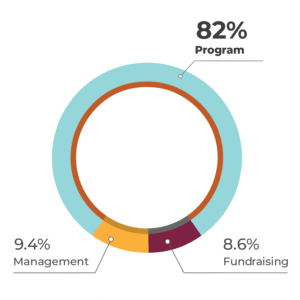In a small village in Nepal, 14-year-old Nisha met a man. He was kind, attentive and charming. As they got to know each other better, she came to trust her new friend. Their relationship developed over the next few months until Nisha thought she’d found a harmless, flattering friend who listened with a sympathetic ear whenever she needed to vent.
Then he convinced her to cross the border with him for a shopping trip.

Two Destiny Rescue agents work a border crossing station in Nepal
Nisha, enamored with the idea of shopping in a different country and excited to develop the relationship further, agreed to join him. But once they crossed the border, she saw the trafficker’s true colors.
The man, once friendly and gentle, became a monster. He locked her in a single room and repeatedly raped Nisha for the next two months.
Fortunately, our agents got a tip about Nisha’s location. We worked with police to rescue the child and arrest her trafficker.
Nisha is one of thousands of children who fall under the spell of child traffickers who use a diabolically insidious technique to obfuscate their true motives: grooming.
Lying their way into naive hearts
Grooming is a common way traffickers exert control over their victims. By manipulating young, developing minds, traffickers can fashion psychological chains as strong as any physical ones.
While traffickers use different methods depending on their target victims or world region, grooming generally involves two inseparable ingredients: deception and trust.
The criminal will go to great pains to gain their target’s trust. By carefully observing their victims and learning about their wants, needs and internal drives, traffickers work tirelessly to become (or at least falsely offer) just what their unsuspecting targets desire.
That looks different in different places. In some situations, traffickers trick their targets into romantic relationships. In others, they offer dream jobs. For some, it’s simply friendship.
Today, we’re going to look at three techniques that we’ve seen human traffickers use to deceive their victims:
1. The sympathetic friend
Let’s return to Nisha’s story. That real-life example demonstrates a real-world strategy we’ve seen implemented in Nepal all too often.
Nisha’s trafficker began the process of grooming the way many do: simply by listening. Traffickers know that desperation for a better life runs rampant in impoverished communities, especially among children. So, the exploiters carefully direct conversations toward difficulties in their targets’ lives, feeding that discontent even as they learn more personal information.

Last year, one case in the Dominican Republic led to the discovery of over 70 women and girls, who had been lured from Colombia and Venezuela after an “employer” offered service industry jobs if they moved to the Dominican Republic
As they listen to their marks, traffickers piece together what frustrates and motivates their victims. During this phase of the relationship, these practiced criminals don’t ask anything of their marks to avoid raising suspicions. We’ve actually had cases of captured traffickers admitting that they carefully calculated how long they could spend developing a relationship with their target to maximize their chances of exploitation while still managing to turn a profit.
And they’re not the only ones using this technique.
2. The love interest
Some traffickers follow the same pattern above, but take it a step further.
After gaining their victims’ trust through listening and sympathizing, traffickers often have enough information to pose as an ideal partner. Traffickers gradually adjust their fake personas, becoming everything their victim wants in a partner. They then foster the relationship to a point where they can convince the victim into an exploitative situation.
Traffickers who use this technique can follow the same pattern described above by luring their victims to another location before revealing their true colors. But we’ve also seen traffickers continue manipulating their relationship with the victims, using their bond as emotional chains to force them into sex trafficking. Sometimes, the manipulation is so complete that the victims will actually defend their traffickers, blinded to their own exploitation.

Many traffickers persuade children to perform sex acts through photos and videos shared via the internet, sometimes blackmailing victims with their own explicit images
We’ve had instances of girls being forced by their exploitative “boyfriends” into sex trafficking, convinced that it was somehow an act of devotion or love. One 14-year-old victim we helped police rescue didn’t even realize her 34-year-old trafficker had kidnapped her; she just thought she was going to live with the man she loved.
In the age of social media, traffickers can easily establish fake profiles using pictures from the internet to pose as an ideal love interest for potential targets. Unfortunately, criminals have met with no small measure of success in this technique, which has largely contributed to the unprecedented rise in the online exploitation of children (OSEC).
The dream job
Traffickers have long used false job offers to lure victims into their clutches. Traditionally, they’d simply place a fake job posting, generally from a neighboring country, and kidnap or entrap the applicants who showed up.

Earlier this year, our team rescued ten young women and girls who had moved to a city in South Asia to find work but were instead lured by a human trafficker into a life of exploitation
But that’s just outright deception. Online predators, in particular, have tweaked this technique by employing grooming methods to increase their chances of success.
Typically, these groomers will approach kids through social media, pretending to represent a talent agency or apparel brand. They take time to compliment the child’s appearance, congratulating them on the “content” they produce. Once the child feels appreciated and flattered, the trafficker will suggest that the victim act as a brand ambassador or model for their fake company.
Then they’ll ask for more photos or videos, sometimes even mailing the child a new outfit, to see if they “test well.” Eventually, they’ll ask for a compromising image, citing a myriad of logical reasons that the image is necessary to move forward. Once traffickers have this image, escape is nearly impossible.
At this point, traffickers often let their false image drop and switch to outright blackmail. They usually threaten to post the image publicly if the child doesn’t send more pictures or money to the trafficker. During this phase, traffickers become so heavy-handed in their demands that some children, crushed beneath the imposed guilt and stress, have committed suicide.
Protecting and rescuing
Grooming is a remarkably subtle means of luring victims into exploitation. The process can last for months, appearing innocent on the surface. Online grooming (and exploitation) often happens right under parents’ noses because every interaction occurs on the child’s phone.
If you see the signs of grooming in a child, such as a sudden change in clothing style, a dramatic jump in time on their devices, unexplained “gifts,” or reclusive, isolating behavior, open a dialogue quickly. The possibility of an awkward conversation is not worth the risk of your child falling into exploitation.

In Cambodia and the Philippines in particular, our agents have reported that some girls are entering the sex industry to fund a lifestyle similar to those seen by social media influencers
If a child in your care has already been affected by grooming and doesn’t think that anything is wrong with the behavior, it is your responsibility to report the crime to law enforcement so that they can stop the trafficker before he causes more harm.
If you’d like to be a part of our rescue efforts in rescuing kids from these traffickers, please consider joining us in this fight. Your contribution can rescue a child from bonds of exploitation. Click below to rescue a child today.
Donate with confidence
Over the last three years, 82% of every dollar we spent was used for programs that benefit the children we defend.
Destiny Rescue is recognized by Guidestar, Charity Navigator, the Better Business Bureau and Excellence in Giving for our commitment to transparency, accountability and financial integrity.



 Australia
Australia New Zealand
New Zealand United Kingdom
United Kingdom

